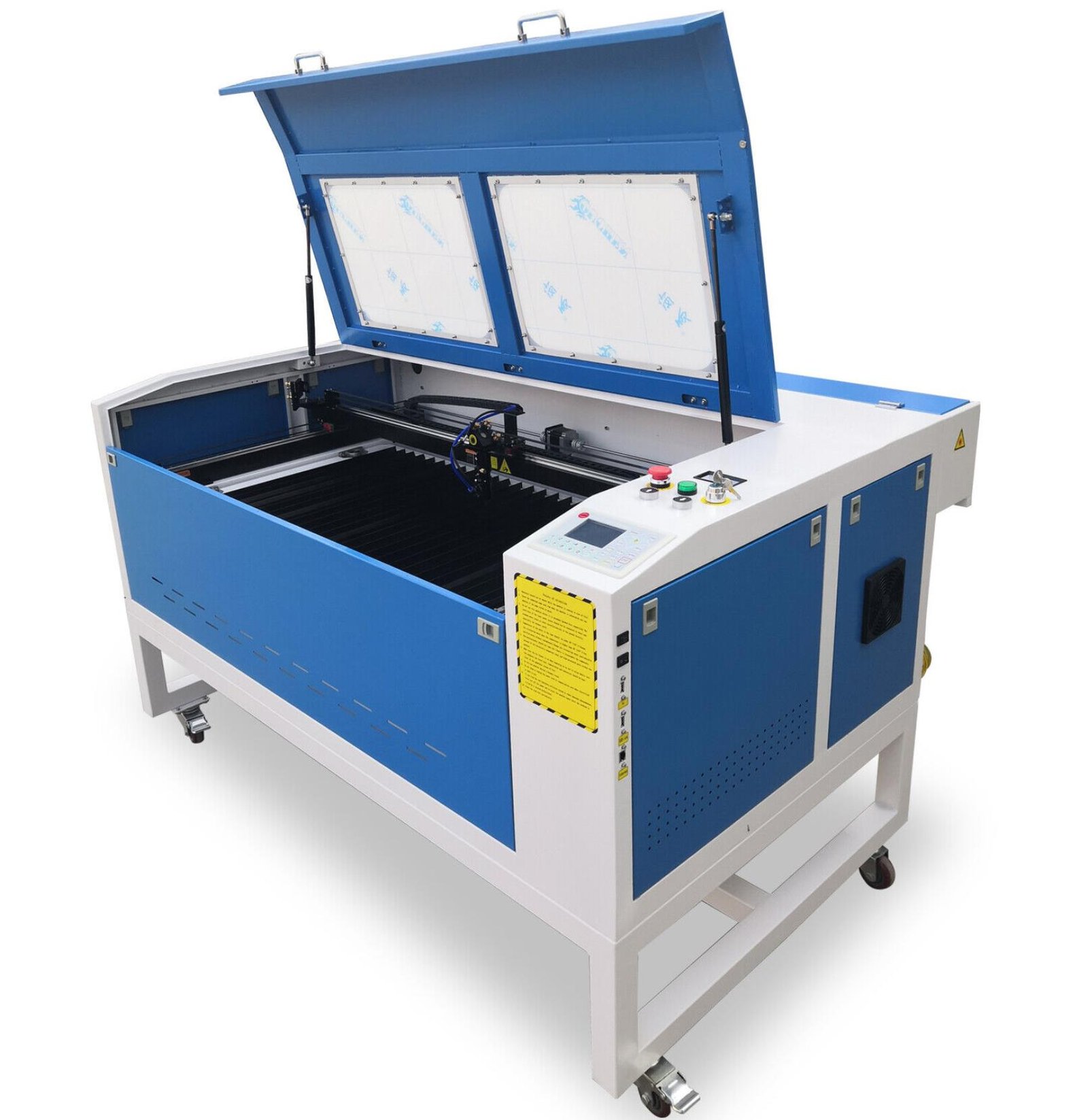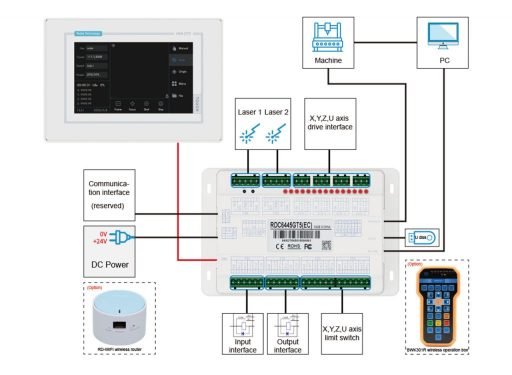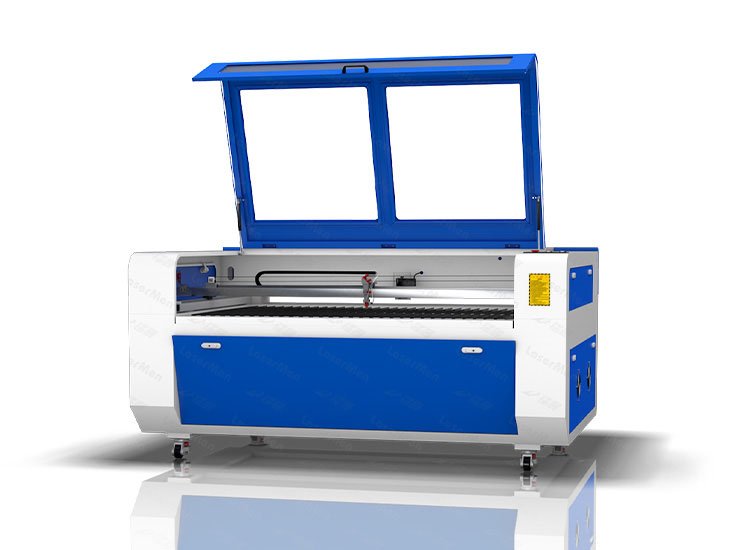ruida controllers
The Ruida RDC6445G laser controller is a versatile and reliable device for CO2 laser cutting and engraving machines. It features a user-friendly control panel and is compatible with K40 lasers and Omtech 50W CO2 lasers. As a Ruida DSP controller, it offers precise axis control and supports various file formats, ensuring high-quality results. With its advanced features, the Ruida 6445 series (RDC6442G and RDC6445G) has become a popular choice for laser enthusiasts and professionals alike.

RDV6442G

6445G
Still not finding what you're looking for? Contact our consultants for more available products.
Full Co2 Laser Controller Solutions Supplier
Ruida controllers offer a user-friendly interface, versatility, precision, compatibility, advanced features, and excellent support, making them a top choice for laser cutting and engraving applications.
User-friendly Interface
Ruida control panels are intuitive and easy to navigate, providing an excellent user experience for operators.
Versatility
Controller Ruida works with various laser machines, including K40, Omtech 50W, and 70W CO2 laser engraver cutters, making it suitable for a wide range of applications.
Precision
As a DSP controller, Ruida ensures precise control over laser cutting and engraving operations, delivering high-quality results.
Compatibility
Ruida CNC controllers, such as RDC6445S and RDC6432, work with numerous design software, allowing users to create designs in their preferred programs.
Advanced Features
Laser DSP controllers like Ruida offer features like real-time simulation, multi-layer processing, and job management, making them a top choice over alternatives like TopWisdom laser controllers.
Support
Ruida provides excellent support and a reliable ecosystem, ensuring smooth integration with laser machines like K40 Ruida controllers, RDC6442G, and RDC6445G controllers for CO2 lasers.

our experience help Boost your business
Our extensive experience with Ruida Controllers can help boost your business by optimizing your laser cutting and engraving processes. By leveraging the user-friendly interface, compatibility with various machines, and advanced features of Ruida Controllers, we can enhance your operational efficiency and product quality.
Our expertise in Ruida’s precision control and versatile functionality allows us to tailor solutions to your specific needs, ensuring your business stays ahead of the competition.
Furthermore, our knowledge of the Ruida ecosystem and support network means you’ll receive the best guidance and recommendations for maximizing the potential of your laser machines, ultimately contributing to your business’s growth and success.
Reliable Shipping Solution
At our company, we understand the importance of receiving your Ruida Controllers promptly and safely. That’s why we offer a reliable shipping solution tailored to your needs.
For smaller orders, we primarily use express courier services and air freight to ensure swift delivery and minimal delays. If you are placing a large volume order, we can arrange efficient sea freight transportation to optimize cost-effectiveness while maintaining the highest standards of care for your valuable Ruida Controllers.
Our commitment to providing seamless logistics and reliable shipping options guarantees that your investment in Ruida Controllers contributes to the success of your business, regardless of the order size.


Quality Control System
We take quality seriously, which is why our CO2 laser lenses undergo strict quality control checks to ensure they arrive intact and ready to use. Our lenses are suitable for a wide range of applications, from 30W beauty laser machines to higher power hybrid cutting machines, and can cut, engrave, and mark a variety of materials including fabric, leather, acrylic, and foam.
Our commitment to quality control means that our customers can rely on our lenses to deliver precise and accurate results every time. Whether you’re working on a small-scale project or a large production run, our lenses are designed to meet your needs. With our rigorous quality control system, you can be confident that our lenses will arrive in perfect condition, ready for use in your laser machine.
Laser Nozzles
Amada Nozzle
Bystronic Nozzle
Mazak Nozzle
Mitsubishi Nozzle
DNE Nozzle
Nukon Nozzle
Ospri Nozzle
Hans Nozzle
Hankwang Nozzle
Laser Protective Windows
Adige BLM Windows
Amada Windows
Bystronic Windows
Eagle Windows
LVD Windows
Mazak Windows
Messer Windows
Mitsubishi Windows
Precitec Windows
Prima Windows
Raytools Windows
Salvagnini Windows
Trumpf Windows
WSX Windows
Welding Windows
DNE Windows
Hankwang Windows
Hans Windows
Laser Ceramic Part
Bystronic Ceramic
DNE Ceramic
Nukon Ceramic
Hans Ceramic
Precitec Ceramic
PENTA Ceramic
IPG Ceramic
Raytools Ceramic
Ospri Ceramic
Friendess Ceramic
Trumpf Ceramic
High Yag Ceramic
Hankwang Ceramic
Laser Head
Raytools Laser Head
WSX Laser Head
Plasma Consumables
Hypertherm Consumables
Kjellberg Consumables
Thermal Dynamics Consumables
Lincoln Consumables
ESAB Consumable
Trafimet Consumable
Is ruida a dsp controller?

Yes, Ruida controllers are a type of Digital Signal Processing (DSP) controllers. They are specifically designed for CO2 laser cutting and engraving machines. DSP controllers are known for their ability to process digital signals in real-time, which is essential for precise control and accurate execution of cutting and engraving operations. Ruida DSP controllers offer advanced features, user-friendly interfaces, and compatibility with various design software, making them a popular choice for laser cutting and engraving applications.
What is a Ruida system?

A Ruida system refers to a control system for CO2 laser cutting and engraving machines that is based on Ruida controllers. Ruida controllers are a type of Digital Signal Processing (DSP) controller designed to manage and optimize laser machine operations, such as movement, laser power, cutting speed, and other machine-related settings.
A Ruida system typically includes the following components:
- Ruida controller: The core component that manages the operation of the laser machine, ensuring precise control and high-quality results.
- Control panel: A user-friendly interface, usually featuring an LCD screen or touch panel, that allows operators to adjust settings, control the machine, and monitor its progress.
- Software: Ruida controllers are compatible with various design software, such as CorelDraw, AutoCAD, and Adobe Illustrator, enabling users to create designs in their preferred programs and send them directly to the controller for execution.
- Connectivity: Ruida systems can be connected to a computer via USB or Ethernet for transferring files and remote control.
Overall, a Ruida system is an advanced and reliable solution for managing CO2 laser cutting and engraving machines, providing excellent performance, versatility, and ease of use.
What does a laser controller do?

A laser controller is an essential component of a laser cutting or engraving machine, responsible for managing and controlling the various aspects of the machine’s operation. The primary functions of a laser controller include:
Coordinate Control: The laser controller manages the movement of the laser head and the machine’s axes (X, Y, and sometimes Z) based on the design input, ensuring accurate and precise cutting or engraving.
Power Management: The controller adjusts the laser power output according to the material being processed and the desired depth of cut or engraving. This helps achieve optimal results and prevent damage to the material or the machine.
Speed Control: Laser controllers regulate the cutting or engraving speed to maintain consistent quality and accuracy across the entire design, taking into consideration factors such as material type and thickness.
Design Execution: The controller interprets design files (e.g., DXF, PLT, AI) from compatible software and translates them into machine-readable instructions, ensuring the laser machine executes the design accurately.
Real-time Monitoring: Laser controllers often provide real-time feedback on the machine’s status, enabling operators to monitor the progress of the cutting or engraving operation and make adjustments as needed.
Safety Features: Many laser controllers come with built-in safety features, such as emergency stop buttons, lid protection, and water cooling system monitoring, to ensure the safe operation of the laser
What is the difference between Ruida controller 6442 and 6445?
The Ruida RDC6442 and RDC6445 controllers are both popular Digital Signal Processing (DSP) controllers designed for CO2 laser cutting and engraving machines. While they share many similarities, there are some differences between the two models:
Connectivity: The RDC6445 controller typically comes with both USB and Ethernet connectivity options, whereas the RDC6442 controller mainly supports USB connectivity. Ethernet connectivity allows for faster data transfer and remote control of the laser machine.
Display: The RDC6445 controller often features a more advanced display, such as a color touch screen, compared to the RDC6442, which usually has a monochrome screen with buttons for navigation.
Additional Features: The RDC6445 controller may include extra features, such as real-time simulation, enhanced job management, or support for more axes, which are not always available in the RDC6442 controller.
Compatibility: The RDC6445 controller might have better compatibility with a wider range of laser machines and accessories, making it more versatile for various cutting and engraving applications.
Overall, the Ruida RDC6445 controller can be considered an upgraded version of the RDC6442, offering more advanced features, better connectivity, and enhanced compatibility. However, the choice between the two models will ultimately depend on your specific requirements,
What is a DSP controller?
A DSP (Digital Signal Processing) controller is a type of electronic device that uses digital signal processing techniques to manipulate and process signals in real-time. DSP controllers are widely used in various applications and industries, such as audio processing, telecommunications, and control systems for industrial equipment.
In the context of laser cutting and engraving machines, a DSP controller is responsible for managing the operation of the machine, ensuring precise control over laser power, movement, and cutting/engraving speed. The primary functions of a DSP controller in a laser machine include:
- Interpreting design files: DSP controllers interpret design files from compatible software and translate them into machine-readable instructions to execute the design accurately.
- Coordinate control: DSP controllers manage the movement of the laser head and the machine’s axes (X, Y, and sometimes Z) based on the design input, ensuring accurate and precise cutting or engraving.
- Power and speed management: These controllers regulate the laser power output and cutting/engraving speed according to the material being processed and the desired depth, maintaining consistent quality and accuracy across the entire design.
- Real-time monitoring: DSP controllers provide real-time feedback on the machine’s status, enabling operators to monitor the progress of the cutting or engraving operation and make adjustments as needed.
- Safety features: Many DSP controllers come with built-in safety features, such as emergency stop buttons, lid protection, and water cooling system monitoring, to ensure the safe operation of the laser machine.
- User Interface: DSP controllers often feature a user-friendly interface, such as an LCD screen or touch panel, allowing operators to easily adjust settings, control the machine, and monitor its progress.
- Compatibility: DSP controllers are designed to work with various design software, such as CorelDraw, Adobe Illustrator, and AutoCAD, enabling users to create designs in their preferred programs and send them directly to the controller for execution.
- Connectivity: These controllers can be connected to a computer via USB, Ethernet, or other communication methods for transferring files and remote control.
In summary, a DSP controller is a critical component of a laser cutting or engraving machine, responsible for managing the machine’s operation and ensuring precise control, optimal performance, and high-quality results. Their advanced features, compatibility, and real-time processing capabilities make them an essential part of modern laser cutting and engraving systems.
Is a DSP a controller or processor?
A Digital Signal Processor (DSP) is a specialized microprocessor designed to process digital signals, such as audio, video, or sensor data, in real-time. It is optimized for performing mathematical operations and signal processing algorithms more efficiently than general-purpose processors.
A DSP controller, on the other hand, is a specific type of control system that utilizes a DSP to manage and control various aspects of a device or machine, such as a laser cutter, engraver, or CNC machine. In this context, the DSP acts as the core processor within the controller, executing the required signal processing tasks and managing the machine’s operation.
In summary, a DSP is a processor optimized for digital signal processing tasks, while a DSP controller is a control system that uses a DSP to manage and control the operation of a specific device or machine.
What is the difference between DSP and controller?
The primary difference between a Digital Signal Processor (DSP) and a controller lies in their specific functions and applications:
Digital Signal Processor (DSP): A DSP is a specialized microprocessor designed for processing digital signals, such as audio, video, or sensor data, in real-time. It is optimized for performing mathematical operations and signal processing algorithms more efficiently than general-purpose processors. DSPs are widely used in various applications and industries, including audio processing, telecommunications, image processing, and control systems for industrial equipment.
Controller: A controller is a device or system that manages and controls the operation of a specific device or machine, such as a laser cutter, engraver, CNC machine, or other industrial equipment. Controllers can be either hardware-based or software-based, and their primary function is to regulate the device’s operation by processing input data, executing commands, and managing the machine’s movements, speeds, and other parameters. Controllers can use different types of processors, including microprocessors, microcontrollers, or DSPs, depending on the specific application and requirements.
In summary, a DSP is a specialized processor optimized for digital signal processing tasks, while a controller is a system or device responsible for managing and controlling the operation of a specific device or machine. A DSP can be used as the core processing component within a controller, but not all controllers utilize DSPs.
Why do we need DSP?
Digital Signal Processing (DSP) is essential in modern technology due to its ability to process and manipulate digital signals efficiently and in real-time. DSPs play a crucial role in various applications and industries, offering several benefits over traditional analog processing or general-purpose processors. Some reasons why we need DSP include:
Improved Signal Quality: DSPs can filter, amplify, or compress digital signals, enhancing their quality and reducing noise, distortion, or other unwanted artifacts.
Real-time Processing: DSPs are designed for high-speed processing, allowing them to handle real-time applications, such as audio or video streaming, without significant delays.
Efficiency: DSPs are optimized for mathematical operations and signal processing algorithms, enabling them to perform these tasks more efficiently than general-purpose processors, resulting in lower power consumption and faster processing speeds.
Flexibility: DSPs can be reprogrammed or updated with new algorithms or firmware, providing the flexibility to adapt to changing requirements or improve performance over time.
Data Compression: DSPs can compress digital signals, reducing the amount of data that needs to be stored or transmitted, which is particularly useful in applications like digital media or telecommunications.
Error Detection and Correction: DSPs can identify and correct errors in digital signals, improving the reliability and accuracy of the transmitted or stored data.
Adaptability: DSPs can adapt to changing conditions or environments, making them suitable for applications that require real-time adjustment or optimization, such as noise-canceling headphones or adaptive control systems.
Integration: DSPs can be easily integrated into other electronic systems, such as microcontrollers or ASICs (Application-Specific Integrated Circuits), enabling the development of compact, efficient, and cost-effective devices with advanced capabilities.
Advanced Applications: DSPs enable the development of sophisticated applications that would be challenging or impossible to achieve with traditional analog processing or general-purpose processors. Examples include image and video processing, speech recognition, radar and sonar systems, and digital communication systems.
Improved Performance: By using DSPs, devices can achieve superior performance in terms of speed, precision, and reliability, leading to enhanced user experiences and better overall product quality.
Noise Reduction: DSPs can effectively reduce or eliminate noise in various applications, such as audio processing, resulting in a cleaner and more accurate output.
Automation and Control: DSPs are extensively used in automation and control systems, enabling precise control and monitoring of devices or processes in industries like manufacturing, automotive, and aerospace.
In summary, DSPs are essential in modern technology due to their ability to process digital signals efficiently and in real-time, offering numerous benefits and enabling advanced applications across various industries. Their flexibility, efficiency, and adaptability make them a crucial component in the development and operation of electronic systems and devices.
Is ruida a dsp controller Is a DSP a FPGA?

Ruida is a DSP controller: Ruida controllers, such as RDC6442 and RDC6445, are Digital Signal Processing (DSP) controllers designed for managing and controlling CO2 laser cutting and engraving machines. They utilize DSP technology to process and interpret design files, regulate laser power and cutting/engraving speed, and manage the machine’s operation.
A DSP is not an FPGA: A Digital Signal Processor (DSP) is a specialized microprocessor designed for efficiently processing digital signals, such as audio, video, or sensor data, in real-time. It is optimized for performing mathematical operations and signal processing algorithms.
An FPGA (Field-Programmable Gate Array) is a different type of electronic component. It is an integrated circuit that can be programmed by the user to perform custom digital logic functions. Unlike a DSP, which is a fixed processor architecture designed specifically for signal processing tasks, an FPGA can be reconfigured to implement various types of digital logic circuits, making it more versatile.
While both DSPs and FPGAs are used in various applications and can process digital signals, they serve different purposes and have distinct architectures. DSPs are specialized processors designed specifically for signal processing tasks, whereas FPGAs are programmable logic devices that can be customized to perform a wide range of digital functions.
Why FPGA is better than DSP?
FPGA (Field-Programmable Gate Array) and DSP (Digital Signal Processor) both serve specific purposes and have distinct architectures, making them suitable for different applications. While it’s not accurate to say that one is universally better than the other, there are some advantages to using FPGAs in certain situations:
Flexibility: FPGAs can be reconfigured to implement various types of digital logic circuits, making them more versatile than DSPs, which are designed specifically for signal processing tasks. This flexibility allows FPGAs to adapt to changing requirements or new algorithms.
Parallelism: FPGAs can execute multiple tasks simultaneously due to their parallel architecture. This feature enables them to handle complex, high-speed data processing tasks more efficiently than DSPs, which typically have a more serial architecture.
Customization: FPGAs can be tailored to specific applications, resulting in highly optimized hardware implementations that can outperform DSPs in terms of speed, power consumption, and resource utilization.
Intellectual Property (IP) Protection: Since FPGAs can be programmed to perform custom digital logic functions, they offer a higher degree of IP protection, making it more difficult for competitors to reverse-engineer a design.
Rapid Prototyping: FPGAs can be quickly reprogrammed, allowing for rapid prototyping and design iteration. This feature enables engineers to test and refine their designs more easily and cost-effectively than with DSPs, which may require specialized hardware or software tools for modification.
Long-term support: FPGAs can continue to be reprogrammed and updated with new functionality even after they have been deployed in a system, which can extend the useful life of a product and reduce the need for costly hardware replacements.
Scalability: FPGA designs can be easily scaled up or down to meet different performance or resource requirements, making them more adaptable to various system needs than DSPs, which may require a complete redesign or different processor to accommodate changes.
Integration: FPGAs can be integrated with other components, such as microprocessors or memory, on a single chip, creating System-on-Chip (SoC) solutions. This integration can lead to smaller form factors, lower power consumption, and reduced overall system complexity.
However, it’s essential to note that these advantages are dependent on the specific application and requirements. In some cases, a DSP may be more appropriate due to its specialized processing capabilities, lower cost, or ease of use. The choice between FPGA and DSP ultimately depends on factors such as the desired performance, flexibility, cost, development time, and the specific application’s requirements.
Is DSP a microcontroller?
A Digital Signal Processor (DSP) is not a microcontroller, although both are types of specialized processors designed for specific applications.
Digital Signal Processor (DSP): A DSP is a specialized microprocessor designed for efficiently processing digital signals, such as audio, video, or sensor data, in real-time. It is optimized for performing mathematical operations and signal processing algorithms. DSPs are widely used in various applications and industries, including audio processing, telecommunications, image processing, and control systems for industrial equipment.
Microcontroller: A microcontroller is a compact, integrated circuit that combines a processor, memory, and input/output (I/O) peripherals on a single chip. It is designed to control and manage simple to moderately complex electronic systems, such as home appliances, automotive systems, or embedded devices. Microcontrollers are typically used in applications that require low power consumption, cost efficiency, and a small form factor.
In summary, a DSP is a specialized processor optimized for digital signal processing tasks, while a microcontroller is an all-in-one integrated circuit designed to control and manage various electronic systems. Although both types of processors can be used in control applications, they have different architectures and serve distinct purposes.
Is FPGA a controller or processor?
An FPGA (Field-Programmable Gate Array) is neither a controller nor a processor in the traditional sense. Instead, it is a type of programmable logic device that can be customized to implement various digital logic functions or circuits. FPGAs consist of an array of programmable logic blocks and interconnects, which can be configured by the user to perform specific tasks.
However, FPGAs can be used to create controllers or processors by programming them to perform specific functions or emulate the behavior of a processor or controller. The versatility and reconfigurability of FPGAs allow them to be utilized in a wide range of applications, including:
- Implementing custom controllers for managing specific devices or systems, such as robotics, motor control, or communication systems.
- Creating custom processor architectures tailored to specific applications, such as signal processing, cryptography, or machine learning.
In summary, an FPGA is a programmable logic device that can be configured to perform various digital functions, including implementing controllers or processors. While it is not a controller or processor itself, it can be used to create custom designs that serve these roles.
Request A Free Quote
Have any questions about laser parts?
Don’t hesitate to contact us. Lasersourcing’s product specialists are very happy to help you and provide a variety of flexible and reliable solutions to help you solve various problems.
Tel
+86-15370952128
lasersourcing@hotmail.com
15370952128
+86-15370952128
